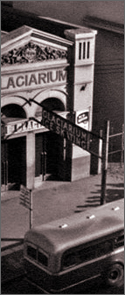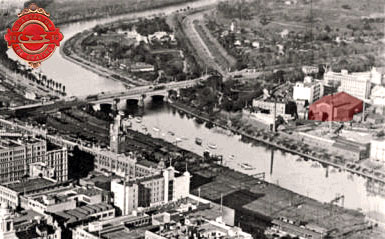
Image above:
The Melbourne Glaciarium is the red brick building on the the right of this 1906 postcard. (Click picture for larger image).
'T. CRAINE'S MOTOR CAR and CARRIAGE WORKS. City Road, First Street to right over Princes Bridge next GLACIARIUM'.
Picture, State Library of Victoria,
Date(s) of creation: [ca. 1906] [53]

Image above:
Melbourne 'Glaciarium' Interior c.1906. (Click picture for larger image).

Image above:
Melbourne 'Glaciarium', c. 1950, on City Road, now occupied by Southgate. This secton of the façade, which can also be seen in the aerial photo (Fig. 2) was probably added after it first opened in 1906, by infilling apron right up to the edge of City Rd. Further back, the main trussed roof was much higher. By this time, Nicholas Pty Ltd, the Aspro people, had built the large building on the left. (Click picture for larger image).


Cradle of Australian Ice Hockey
Southgate was always a meeting point on the Yarra River. A waterfall at Princes Bridge protected the fresh water coming downstream while trading ships could navigate upstream from the saltwater of Port Phillip Bay. South of the river were breweries and food processing, while shipping and trading utilised the docks and warehouses. Over time, the area consolidated into an industrial district; a messy collection of old buildings and vacant government land.
Henry Newman Reid, a Melbourne refrigeration Engineer, established Australia's first ice rink in Adelaide as the leader of an entrepreneurial syndicate formed in 1903. Reid was apparently born in Edinburgh and immigrated sometime before 1888. His refrigeration expertise was highly regarded in the industry. He specialised in valves and temperature controls and had applied for several patents. He had 3 sons, Hal, Andy, Les (Snowy) and a daughter, Merrilees. He teamed up with Dunbar Poole, a proficient skater and experienced ice rink manager who had arrived in Melbourne from Glasgow in 1899. Poole was considered the most experienced rink manager in Great Britain, having produced many successful ice shows, many featuring his own costumes and set designs. At the turn of the century, Great Britain was a training hub for many international skaters and produced most of the ice shows in Europe.
The Adelaide rink opened in 1904 as the 'Glaciarium Ice Palace', at 91 Hindley Street in the city centre. The building was a converted from a cyclorama. The floor area comprised over 8,000 superficial feet (80 squares or 743 square metres) of real ice. It was circular in shape with a column in the centre. The column was surrounded by upholstered seats for skaters to rest and a band played there during public skating sessions. A notice in the Adelaide Advertiser on 11th October 1904 reported the rink had seating accommodation for 3,000 (equivalent to the Palais Theatre in Melbourne) and was lit by electricity.
However, refrigerant was piped from the local ice works a quarter of a mile away which made operation difficult. It closed in 1905, just over a year after opening, despite its reported popularity as a favourite and fashionable social venue featuring figure skating, dancing on ice, ice hockey and fancy costume carnivals. The building was converted to an indoor cycling and roller skating track and then in 1908 into a picture theatre by another Scotsman, T.J. West. It was then known as West’s Pictures which later became part of the Greater Union Organization. The original Adelaide Glaciarium building still exists having been converted again into the Grainger studio, the home of the Adelaide Symphony Orchestra. [2]
In 1905, H. Newman-Reid returned to Melbourne where he built and managed its first ice rink, the Glaciarium, opening on 11 June 1906. It was a very social sort of place with loges all around the ice surface, like in a theatre or opera house. The loges were heated for the comfort of patrons and for exhibitions during the carnivals held there. The Glaciarium had a floor space of 14,500 square feet (1,347 square metres) and it was claimed to be exceeded in size by only two in the United States. Initially a Professor Webster gave instruction in skating.
The rink traditionally opened for skating only in the winter months. In the summer, it was leased to West’s Pictures and occasionally used by circuses. Hockey, carnivals, figure skating and speed skating played important roles and later, Professor Langley, a renowned skating teacher of the time, gave instruction. Dunbar Poole was also closely associated with that rink in its first year. The sessions always finished with “Till We Meet Again”.
Little is known about the operations of the Melbourne Glaciarium during its early years other than that Reid continued to manage it. He was winner of the men's figure skating event in the Sydney "Nationals" in 1911. It remained open until 1917; a newsreel of the time shows the building being destroyed by fire. It was closed until 1923 then re-opened (on its original site) under the management of Leo Molloy who continued in that role until it closed again for the last time in 1957. The building finally reached its end when for the second and last time it was destroyed by fire on Good Friday in 1964. By the 1940s, the Trocadero dance hall, on the art gallery site, and Glaciarium, where the twin Southgate commercial towers now stand, were lonely leisure activities in the area. The big neon sign on the Allens Confectionery factory was the only landmark.
1906, 11 Jun, Opened
1906, 17 Jul, 1st officially-organised ice hockey game in Australia
1907, 'Melbourne Glaciarium' - 1st Australian ice hockey team
1917, Destroyed by fire
1923, Re-opened
1956, Olympics, converted for Basketball and Gymnastics
1957, Closed
1964, Good Friday, Destroyed by fire
 |
| Fig. 1: Aerial Photo, 1950, before the Concert Hall and Arts Centre; today's Southgate. The Glaciarium is marked by the red skater. The rink had access to both City Road and the street behind; the latter now gone to make way for the South Gate development. |
 |
| Fig. 2: View from Melbourne CBD toward The Glaciarium (marked red) in 1950, the same year as the map above. The tall building next to it was Nicholas Pty Ltd, the Aspro factory. The rink was directly beneath the central trussed roof which were supported on the columns visible in the interior image (left). The spaces each side were also large and used for patron seating and entertainment. The size of the building suggests the ice surface was the same as later built in Sydney and the building was larger overall. |
© 2007 Ross Carpenter B Arch (RMIT) M Des (Urban Design) ARAIA. All Rights Reserved. Original Research Nov 07. Reproduction prohibited without prior written permission of the author except for the inclusion of brief quotations in a review.
Citations and Notes:
[1] "Ice Hockey: The NSW Ice Hockey, Association Inc. Australia - Facts and Events 1907-1999" by Sid Tange (199). Extracts are being published on the IHNSW website for the Centenary. Approach with caution; the document contains many errors and ommisions.
[2] History of Skating in Australia, Ice Skating Rinks in Australia and some of the personalities associated with them, Donald McKnight, October 2007 (Friends of ISQ website)
[3] IHA 'Goodall Cip History'